Risk Management System for Railway Transport: Identification, Analysis and Mitigation
VerifiedAdded on 2023/06/13
|13
|3250
|355
AI Summary
This paper discusses the risk management system for railway transport, including hazard identification, risk analysis, and mitigation measures. It also highlights the responsibilities of the project team in implementing the system.
Contribute Materials
Your contribution can guide someone’s learning journey. Share your
documents today.
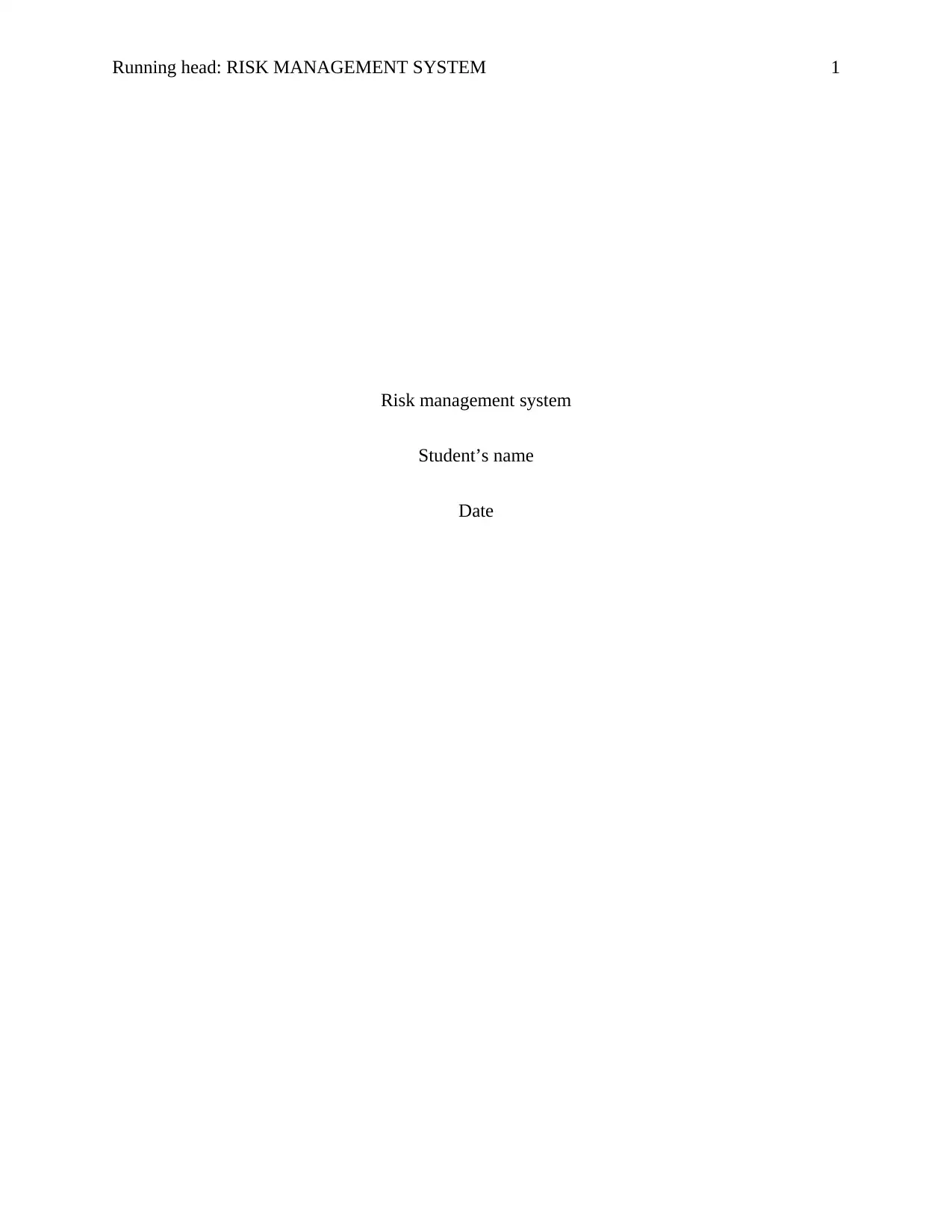
Running head: RISK MANAGEMENT SYSTEM 1
Risk management system
Student’s name
Date
Risk management system
Student’s name
Date
Secure Best Marks with AI Grader
Need help grading? Try our AI Grader for instant feedback on your assignments.
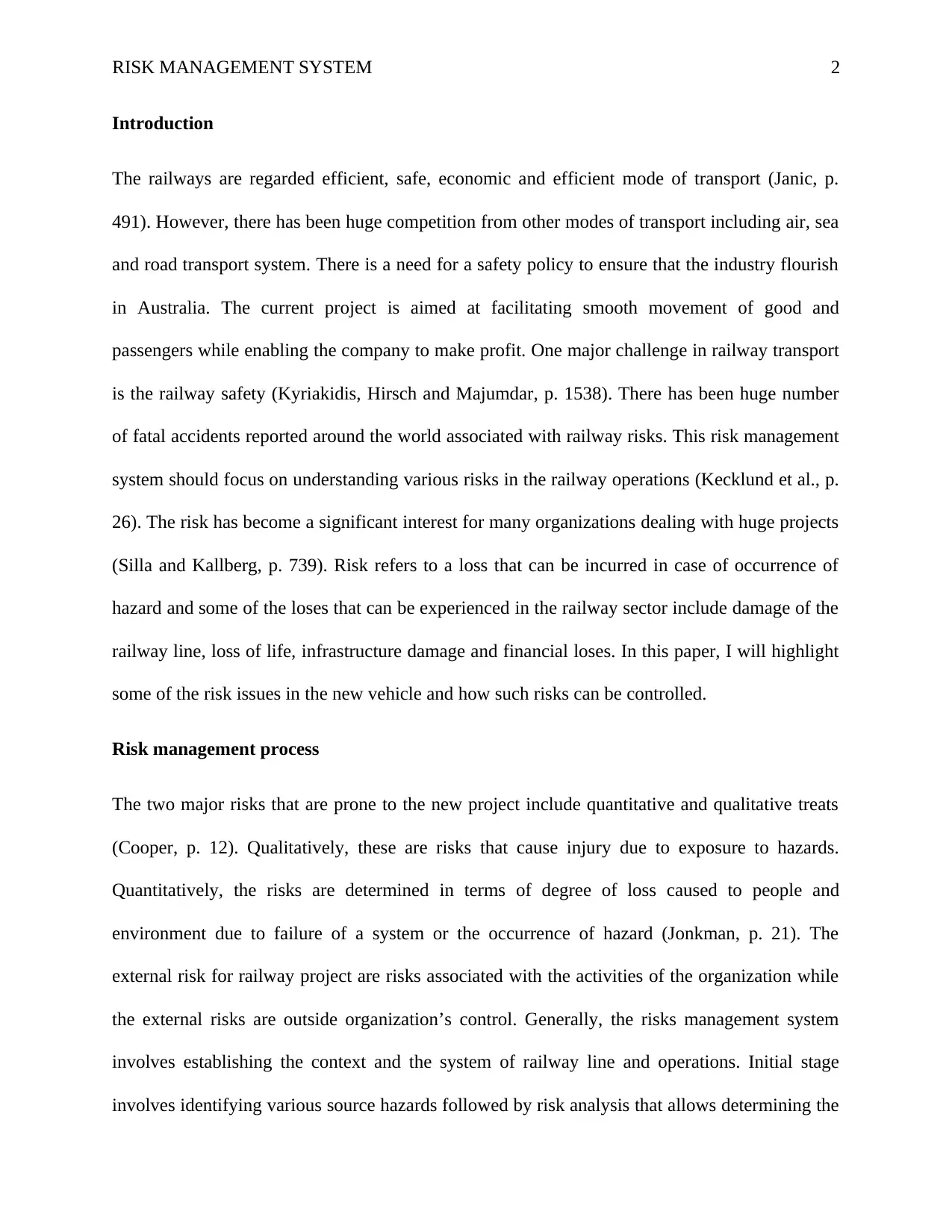
RISK MANAGEMENT SYSTEM 2
Introduction
The railways are regarded efficient, safe, economic and efficient mode of transport (Janic, p.
491). However, there has been huge competition from other modes of transport including air, sea
and road transport system. There is a need for a safety policy to ensure that the industry flourish
in Australia. The current project is aimed at facilitating smooth movement of good and
passengers while enabling the company to make profit. One major challenge in railway transport
is the railway safety (Kyriakidis, Hirsch and Majumdar, p. 1538). There has been huge number
of fatal accidents reported around the world associated with railway risks. This risk management
system should focus on understanding various risks in the railway operations (Kecklund et al., p.
26). The risk has become a significant interest for many organizations dealing with huge projects
(Silla and Kallberg, p. 739). Risk refers to a loss that can be incurred in case of occurrence of
hazard and some of the loses that can be experienced in the railway sector include damage of the
railway line, loss of life, infrastructure damage and financial loses. In this paper, I will highlight
some of the risk issues in the new vehicle and how such risks can be controlled.
Risk management process
The two major risks that are prone to the new project include quantitative and qualitative treats
(Cooper, p. 12). Qualitatively, these are risks that cause injury due to exposure to hazards.
Quantitatively, the risks are determined in terms of degree of loss caused to people and
environment due to failure of a system or the occurrence of hazard (Jonkman, p. 21). The
external risk for railway project are risks associated with the activities of the organization while
the external risks are outside organization’s control. Generally, the risks management system
involves establishing the context and the system of railway line and operations. Initial stage
involves identifying various source hazards followed by risk analysis that allows determining the
Introduction
The railways are regarded efficient, safe, economic and efficient mode of transport (Janic, p.
491). However, there has been huge competition from other modes of transport including air, sea
and road transport system. There is a need for a safety policy to ensure that the industry flourish
in Australia. The current project is aimed at facilitating smooth movement of good and
passengers while enabling the company to make profit. One major challenge in railway transport
is the railway safety (Kyriakidis, Hirsch and Majumdar, p. 1538). There has been huge number
of fatal accidents reported around the world associated with railway risks. This risk management
system should focus on understanding various risks in the railway operations (Kecklund et al., p.
26). The risk has become a significant interest for many organizations dealing with huge projects
(Silla and Kallberg, p. 739). Risk refers to a loss that can be incurred in case of occurrence of
hazard and some of the loses that can be experienced in the railway sector include damage of the
railway line, loss of life, infrastructure damage and financial loses. In this paper, I will highlight
some of the risk issues in the new vehicle and how such risks can be controlled.
Risk management process
The two major risks that are prone to the new project include quantitative and qualitative treats
(Cooper, p. 12). Qualitatively, these are risks that cause injury due to exposure to hazards.
Quantitatively, the risks are determined in terms of degree of loss caused to people and
environment due to failure of a system or the occurrence of hazard (Jonkman, p. 21). The
external risk for railway project are risks associated with the activities of the organization while
the external risks are outside organization’s control. Generally, the risks management system
involves establishing the context and the system of railway line and operations. Initial stage
involves identifying various source hazards followed by risk analysis that allows determining the
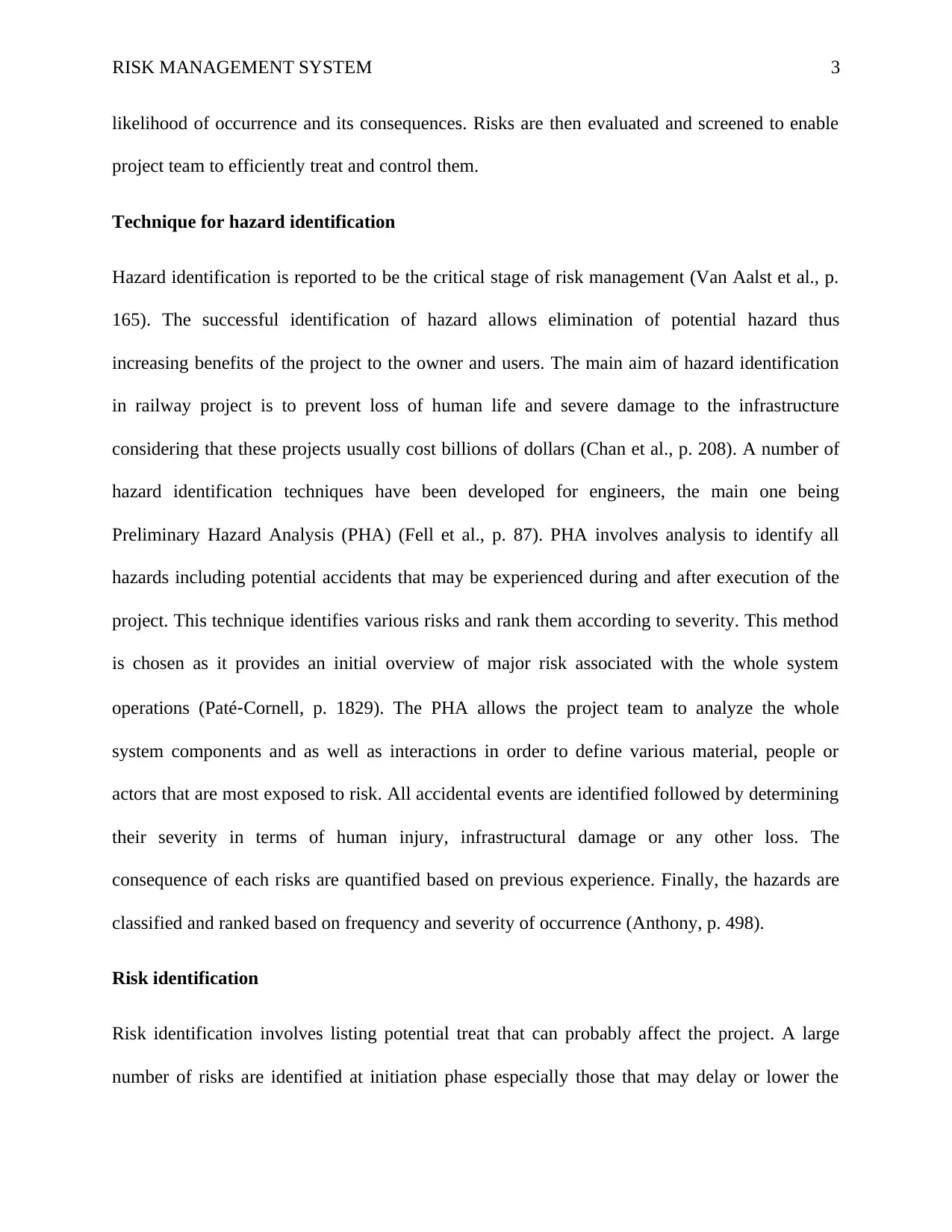
RISK MANAGEMENT SYSTEM 3
likelihood of occurrence and its consequences. Risks are then evaluated and screened to enable
project team to efficiently treat and control them.
Technique for hazard identification
Hazard identification is reported to be the critical stage of risk management (Van Aalst et al., p.
165). The successful identification of hazard allows elimination of potential hazard thus
increasing benefits of the project to the owner and users. The main aim of hazard identification
in railway project is to prevent loss of human life and severe damage to the infrastructure
considering that these projects usually cost billions of dollars (Chan et al., p. 208). A number of
hazard identification techniques have been developed for engineers, the main one being
Preliminary Hazard Analysis (PHA) (Fell et al., p. 87). PHA involves analysis to identify all
hazards including potential accidents that may be experienced during and after execution of the
project. This technique identifies various risks and rank them according to severity. This method
is chosen as it provides an initial overview of major risk associated with the whole system
operations (Paté‐Cornell, p. 1829). The PHA allows the project team to analyze the whole
system components and as well as interactions in order to define various material, people or
actors that are most exposed to risk. All accidental events are identified followed by determining
their severity in terms of human injury, infrastructural damage or any other loss. The
consequence of each risks are quantified based on previous experience. Finally, the hazards are
classified and ranked based on frequency and severity of occurrence (Anthony, p. 498).
Risk identification
Risk identification involves listing potential treat that can probably affect the project. A large
number of risks are identified at initiation phase especially those that may delay or lower the
likelihood of occurrence and its consequences. Risks are then evaluated and screened to enable
project team to efficiently treat and control them.
Technique for hazard identification
Hazard identification is reported to be the critical stage of risk management (Van Aalst et al., p.
165). The successful identification of hazard allows elimination of potential hazard thus
increasing benefits of the project to the owner and users. The main aim of hazard identification
in railway project is to prevent loss of human life and severe damage to the infrastructure
considering that these projects usually cost billions of dollars (Chan et al., p. 208). A number of
hazard identification techniques have been developed for engineers, the main one being
Preliminary Hazard Analysis (PHA) (Fell et al., p. 87). PHA involves analysis to identify all
hazards including potential accidents that may be experienced during and after execution of the
project. This technique identifies various risks and rank them according to severity. This method
is chosen as it provides an initial overview of major risk associated with the whole system
operations (Paté‐Cornell, p. 1829). The PHA allows the project team to analyze the whole
system components and as well as interactions in order to define various material, people or
actors that are most exposed to risk. All accidental events are identified followed by determining
their severity in terms of human injury, infrastructural damage or any other loss. The
consequence of each risks are quantified based on previous experience. Finally, the hazards are
classified and ranked based on frequency and severity of occurrence (Anthony, p. 498).
Risk identification
Risk identification involves listing potential treat that can probably affect the project. A large
number of risks are identified at initiation phase especially those that may delay or lower the
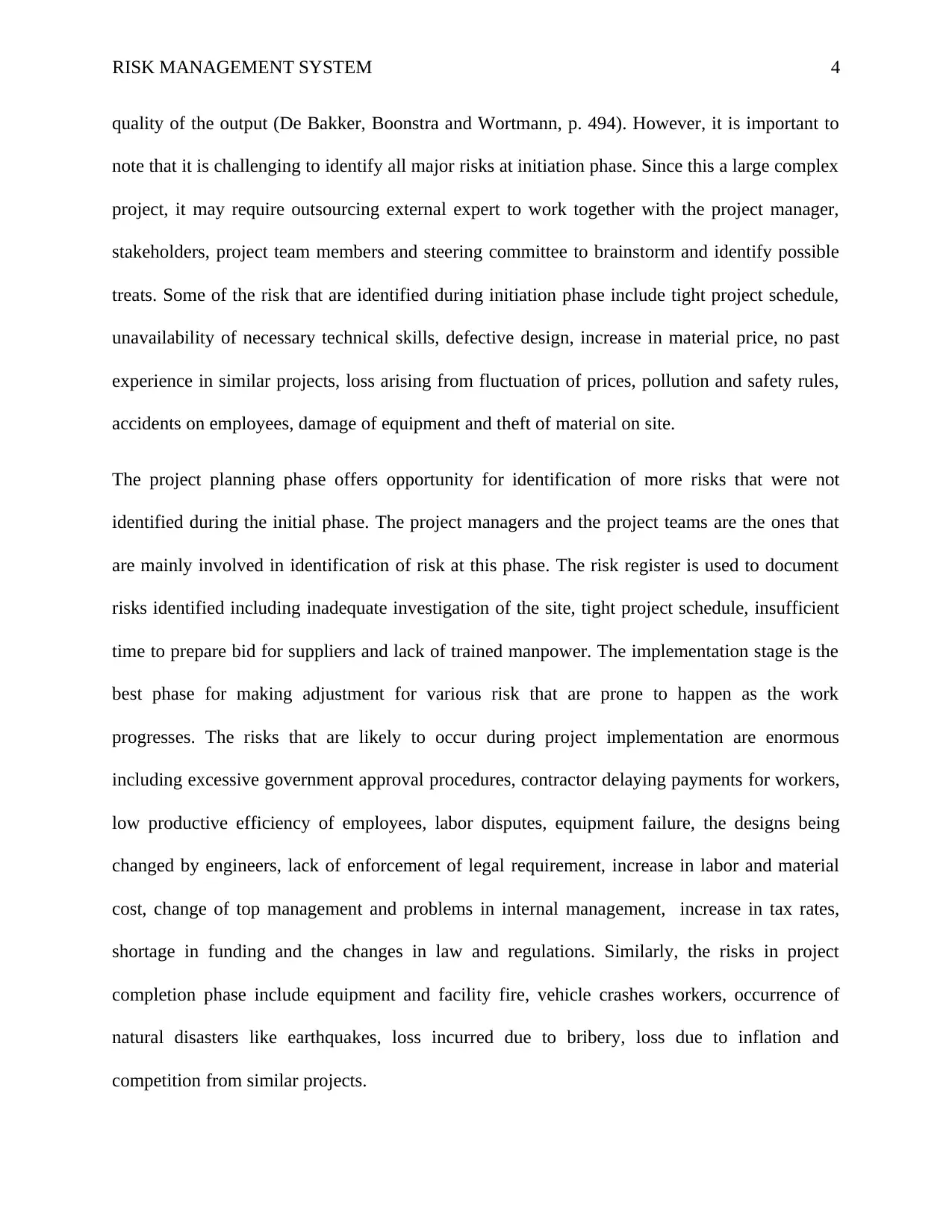
RISK MANAGEMENT SYSTEM 4
quality of the output (De Bakker, Boonstra and Wortmann, p. 494). However, it is important to
note that it is challenging to identify all major risks at initiation phase. Since this a large complex
project, it may require outsourcing external expert to work together with the project manager,
stakeholders, project team members and steering committee to brainstorm and identify possible
treats. Some of the risk that are identified during initiation phase include tight project schedule,
unavailability of necessary technical skills, defective design, increase in material price, no past
experience in similar projects, loss arising from fluctuation of prices, pollution and safety rules,
accidents on employees, damage of equipment and theft of material on site.
The project planning phase offers opportunity for identification of more risks that were not
identified during the initial phase. The project managers and the project teams are the ones that
are mainly involved in identification of risk at this phase. The risk register is used to document
risks identified including inadequate investigation of the site, tight project schedule, insufficient
time to prepare bid for suppliers and lack of trained manpower. The implementation stage is the
best phase for making adjustment for various risk that are prone to happen as the work
progresses. The risks that are likely to occur during project implementation are enormous
including excessive government approval procedures, contractor delaying payments for workers,
low productive efficiency of employees, labor disputes, equipment failure, the designs being
changed by engineers, lack of enforcement of legal requirement, increase in labor and material
cost, change of top management and problems in internal management, increase in tax rates,
shortage in funding and the changes in law and regulations. Similarly, the risks in project
completion phase include equipment and facility fire, vehicle crashes workers, occurrence of
natural disasters like earthquakes, loss incurred due to bribery, loss due to inflation and
competition from similar projects.
quality of the output (De Bakker, Boonstra and Wortmann, p. 494). However, it is important to
note that it is challenging to identify all major risks at initiation phase. Since this a large complex
project, it may require outsourcing external expert to work together with the project manager,
stakeholders, project team members and steering committee to brainstorm and identify possible
treats. Some of the risk that are identified during initiation phase include tight project schedule,
unavailability of necessary technical skills, defective design, increase in material price, no past
experience in similar projects, loss arising from fluctuation of prices, pollution and safety rules,
accidents on employees, damage of equipment and theft of material on site.
The project planning phase offers opportunity for identification of more risks that were not
identified during the initial phase. The project managers and the project teams are the ones that
are mainly involved in identification of risk at this phase. The risk register is used to document
risks identified including inadequate investigation of the site, tight project schedule, insufficient
time to prepare bid for suppliers and lack of trained manpower. The implementation stage is the
best phase for making adjustment for various risk that are prone to happen as the work
progresses. The risks that are likely to occur during project implementation are enormous
including excessive government approval procedures, contractor delaying payments for workers,
low productive efficiency of employees, labor disputes, equipment failure, the designs being
changed by engineers, lack of enforcement of legal requirement, increase in labor and material
cost, change of top management and problems in internal management, increase in tax rates,
shortage in funding and the changes in law and regulations. Similarly, the risks in project
completion phase include equipment and facility fire, vehicle crashes workers, occurrence of
natural disasters like earthquakes, loss incurred due to bribery, loss due to inflation and
competition from similar projects.
Secure Best Marks with AI Grader
Need help grading? Try our AI Grader for instant feedback on your assignments.
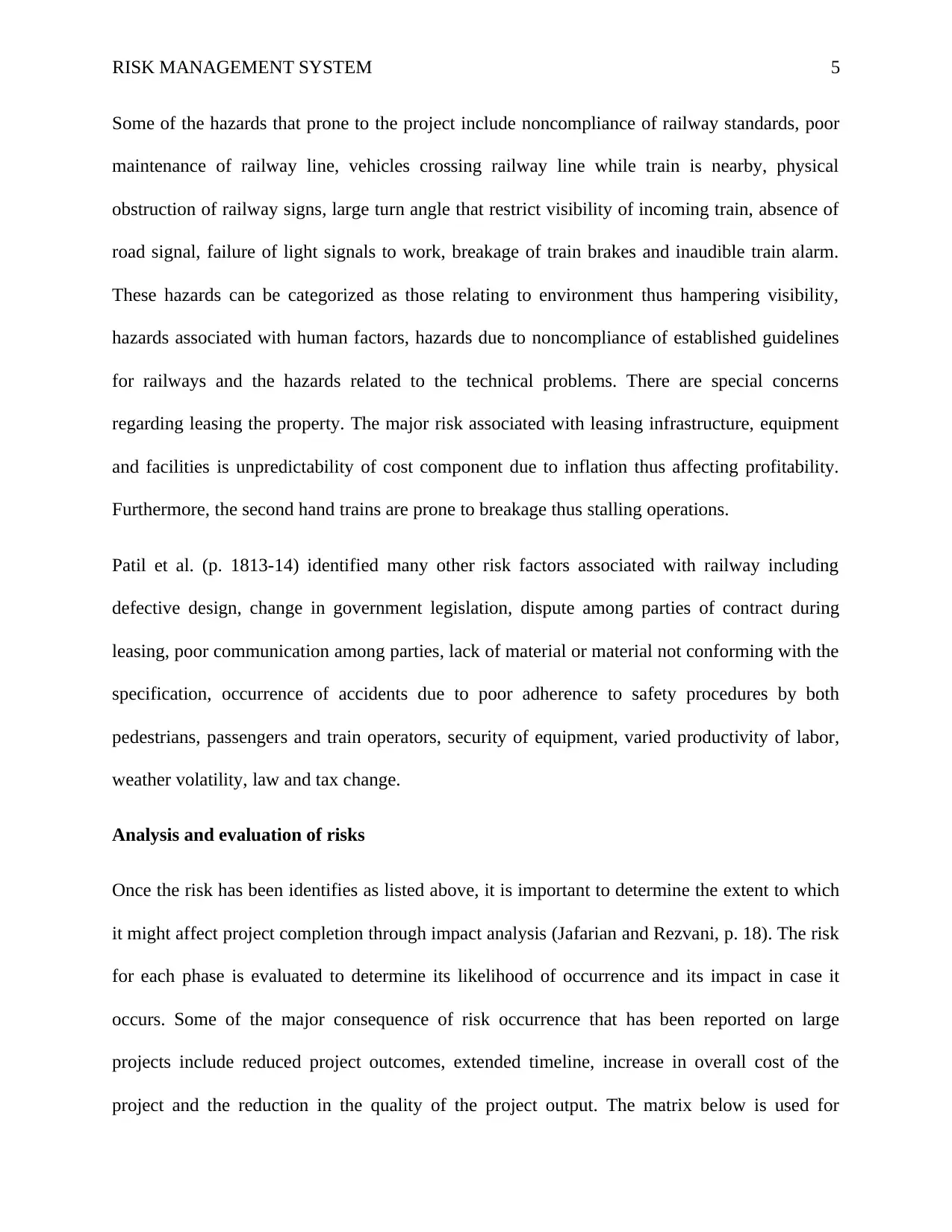
RISK MANAGEMENT SYSTEM 5
Some of the hazards that prone to the project include noncompliance of railway standards, poor
maintenance of railway line, vehicles crossing railway line while train is nearby, physical
obstruction of railway signs, large turn angle that restrict visibility of incoming train, absence of
road signal, failure of light signals to work, breakage of train brakes and inaudible train alarm.
These hazards can be categorized as those relating to environment thus hampering visibility,
hazards associated with human factors, hazards due to noncompliance of established guidelines
for railways and the hazards related to the technical problems. There are special concerns
regarding leasing the property. The major risk associated with leasing infrastructure, equipment
and facilities is unpredictability of cost component due to inflation thus affecting profitability.
Furthermore, the second hand trains are prone to breakage thus stalling operations.
Patil et al. (p. 1813-14) identified many other risk factors associated with railway including
defective design, change in government legislation, dispute among parties of contract during
leasing, poor communication among parties, lack of material or material not conforming with the
specification, occurrence of accidents due to poor adherence to safety procedures by both
pedestrians, passengers and train operators, security of equipment, varied productivity of labor,
weather volatility, law and tax change.
Analysis and evaluation of risks
Once the risk has been identifies as listed above, it is important to determine the extent to which
it might affect project completion through impact analysis (Jafarian and Rezvani, p. 18). The risk
for each phase is evaluated to determine its likelihood of occurrence and its impact in case it
occurs. Some of the major consequence of risk occurrence that has been reported on large
projects include reduced project outcomes, extended timeline, increase in overall cost of the
project and the reduction in the quality of the project output. The matrix below is used for
Some of the hazards that prone to the project include noncompliance of railway standards, poor
maintenance of railway line, vehicles crossing railway line while train is nearby, physical
obstruction of railway signs, large turn angle that restrict visibility of incoming train, absence of
road signal, failure of light signals to work, breakage of train brakes and inaudible train alarm.
These hazards can be categorized as those relating to environment thus hampering visibility,
hazards associated with human factors, hazards due to noncompliance of established guidelines
for railways and the hazards related to the technical problems. There are special concerns
regarding leasing the property. The major risk associated with leasing infrastructure, equipment
and facilities is unpredictability of cost component due to inflation thus affecting profitability.
Furthermore, the second hand trains are prone to breakage thus stalling operations.
Patil et al. (p. 1813-14) identified many other risk factors associated with railway including
defective design, change in government legislation, dispute among parties of contract during
leasing, poor communication among parties, lack of material or material not conforming with the
specification, occurrence of accidents due to poor adherence to safety procedures by both
pedestrians, passengers and train operators, security of equipment, varied productivity of labor,
weather volatility, law and tax change.
Analysis and evaluation of risks
Once the risk has been identifies as listed above, it is important to determine the extent to which
it might affect project completion through impact analysis (Jafarian and Rezvani, p. 18). The risk
for each phase is evaluated to determine its likelihood of occurrence and its impact in case it
occurs. Some of the major consequence of risk occurrence that has been reported on large
projects include reduced project outcomes, extended timeline, increase in overall cost of the
project and the reduction in the quality of the project output. The matrix below is used for
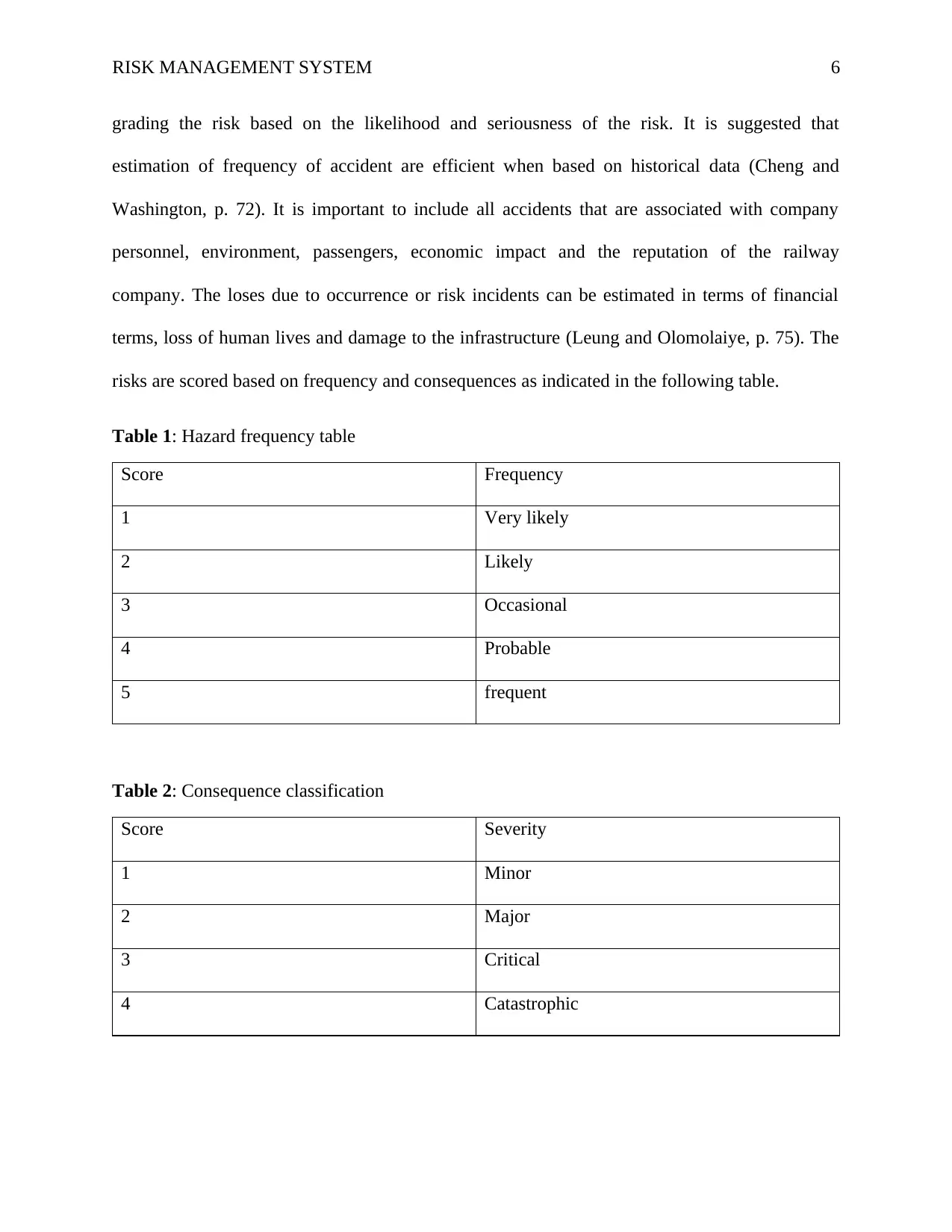
RISK MANAGEMENT SYSTEM 6
grading the risk based on the likelihood and seriousness of the risk. It is suggested that
estimation of frequency of accident are efficient when based on historical data (Cheng and
Washington, p. 72). It is important to include all accidents that are associated with company
personnel, environment, passengers, economic impact and the reputation of the railway
company. The loses due to occurrence or risk incidents can be estimated in terms of financial
terms, loss of human lives and damage to the infrastructure (Leung and Olomolaiye, p. 75). The
risks are scored based on frequency and consequences as indicated in the following table.
Table 1: Hazard frequency table
Score Frequency
1 Very likely
2 Likely
3 Occasional
4 Probable
5 frequent
Table 2: Consequence classification
Score Severity
1 Minor
2 Major
3 Critical
4 Catastrophic
grading the risk based on the likelihood and seriousness of the risk. It is suggested that
estimation of frequency of accident are efficient when based on historical data (Cheng and
Washington, p. 72). It is important to include all accidents that are associated with company
personnel, environment, passengers, economic impact and the reputation of the railway
company. The loses due to occurrence or risk incidents can be estimated in terms of financial
terms, loss of human lives and damage to the infrastructure (Leung and Olomolaiye, p. 75). The
risks are scored based on frequency and consequences as indicated in the following table.
Table 1: Hazard frequency table
Score Frequency
1 Very likely
2 Likely
3 Occasional
4 Probable
5 frequent
Table 2: Consequence classification
Score Severity
1 Minor
2 Major
3 Critical
4 Catastrophic
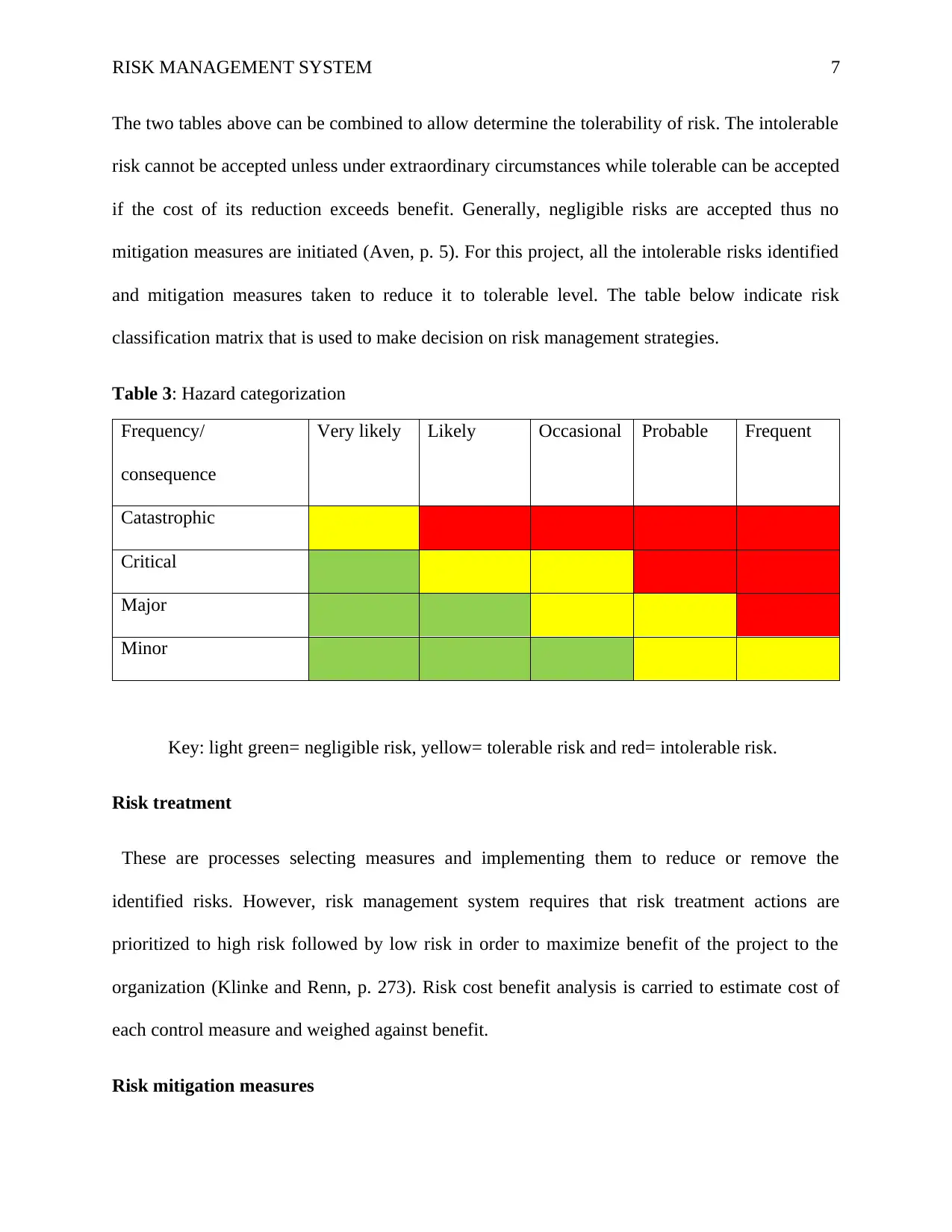
RISK MANAGEMENT SYSTEM 7
The two tables above can be combined to allow determine the tolerability of risk. The intolerable
risk cannot be accepted unless under extraordinary circumstances while tolerable can be accepted
if the cost of its reduction exceeds benefit. Generally, negligible risks are accepted thus no
mitigation measures are initiated (Aven, p. 5). For this project, all the intolerable risks identified
and mitigation measures taken to reduce it to tolerable level. The table below indicate risk
classification matrix that is used to make decision on risk management strategies.
Table 3: Hazard categorization
Frequency/
consequence
Very likely Likely Occasional Probable Frequent
Catastrophic
Critical
Major
Minor
Key: light green= negligible risk, yellow= tolerable risk and red= intolerable risk.
Risk treatment
These are processes selecting measures and implementing them to reduce or remove the
identified risks. However, risk management system requires that risk treatment actions are
prioritized to high risk followed by low risk in order to maximize benefit of the project to the
organization (Klinke and Renn, p. 273). Risk cost benefit analysis is carried to estimate cost of
each control measure and weighed against benefit.
Risk mitigation measures
The two tables above can be combined to allow determine the tolerability of risk. The intolerable
risk cannot be accepted unless under extraordinary circumstances while tolerable can be accepted
if the cost of its reduction exceeds benefit. Generally, negligible risks are accepted thus no
mitigation measures are initiated (Aven, p. 5). For this project, all the intolerable risks identified
and mitigation measures taken to reduce it to tolerable level. The table below indicate risk
classification matrix that is used to make decision on risk management strategies.
Table 3: Hazard categorization
Frequency/
consequence
Very likely Likely Occasional Probable Frequent
Catastrophic
Critical
Major
Minor
Key: light green= negligible risk, yellow= tolerable risk and red= intolerable risk.
Risk treatment
These are processes selecting measures and implementing them to reduce or remove the
identified risks. However, risk management system requires that risk treatment actions are
prioritized to high risk followed by low risk in order to maximize benefit of the project to the
organization (Klinke and Renn, p. 273). Risk cost benefit analysis is carried to estimate cost of
each control measure and weighed against benefit.
Risk mitigation measures
Paraphrase This Document
Need a fresh take? Get an instant paraphrase of this document with our AI Paraphraser
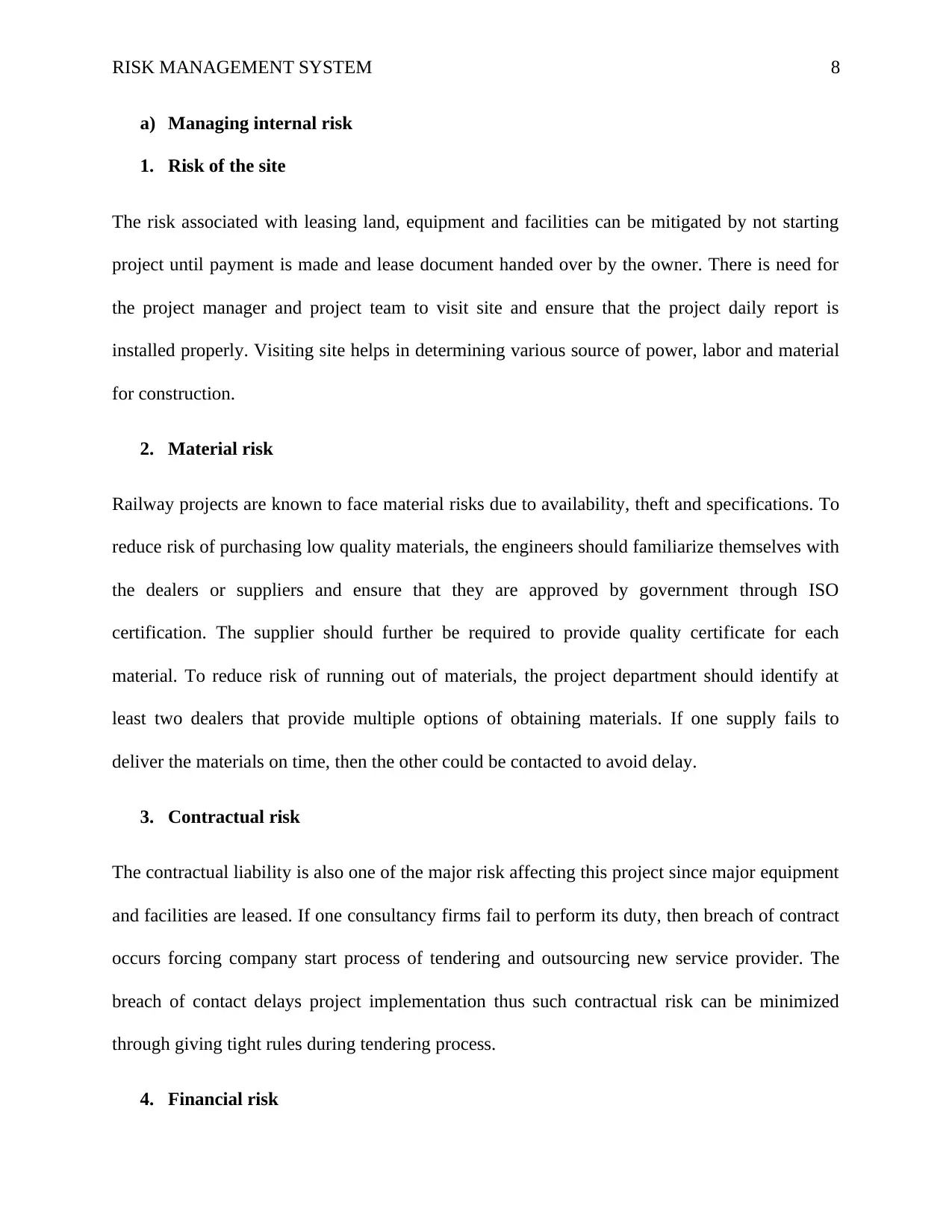
RISK MANAGEMENT SYSTEM 8
a) Managing internal risk
1. Risk of the site
The risk associated with leasing land, equipment and facilities can be mitigated by not starting
project until payment is made and lease document handed over by the owner. There is need for
the project manager and project team to visit site and ensure that the project daily report is
installed properly. Visiting site helps in determining various source of power, labor and material
for construction.
2. Material risk
Railway projects are known to face material risks due to availability, theft and specifications. To
reduce risk of purchasing low quality materials, the engineers should familiarize themselves with
the dealers or suppliers and ensure that they are approved by government through ISO
certification. The supplier should further be required to provide quality certificate for each
material. To reduce risk of running out of materials, the project department should identify at
least two dealers that provide multiple options of obtaining materials. If one supply fails to
deliver the materials on time, then the other could be contacted to avoid delay.
3. Contractual risk
The contractual liability is also one of the major risk affecting this project since major equipment
and facilities are leased. If one consultancy firms fail to perform its duty, then breach of contract
occurs forcing company start process of tendering and outsourcing new service provider. The
breach of contact delays project implementation thus such contractual risk can be minimized
through giving tight rules during tendering process.
4. Financial risk
a) Managing internal risk
1. Risk of the site
The risk associated with leasing land, equipment and facilities can be mitigated by not starting
project until payment is made and lease document handed over by the owner. There is need for
the project manager and project team to visit site and ensure that the project daily report is
installed properly. Visiting site helps in determining various source of power, labor and material
for construction.
2. Material risk
Railway projects are known to face material risks due to availability, theft and specifications. To
reduce risk of purchasing low quality materials, the engineers should familiarize themselves with
the dealers or suppliers and ensure that they are approved by government through ISO
certification. The supplier should further be required to provide quality certificate for each
material. To reduce risk of running out of materials, the project department should identify at
least two dealers that provide multiple options of obtaining materials. If one supply fails to
deliver the materials on time, then the other could be contacted to avoid delay.
3. Contractual risk
The contractual liability is also one of the major risk affecting this project since major equipment
and facilities are leased. If one consultancy firms fail to perform its duty, then breach of contract
occurs forcing company start process of tendering and outsourcing new service provider. The
breach of contact delays project implementation thus such contractual risk can be minimized
through giving tight rules during tendering process.
4. Financial risk
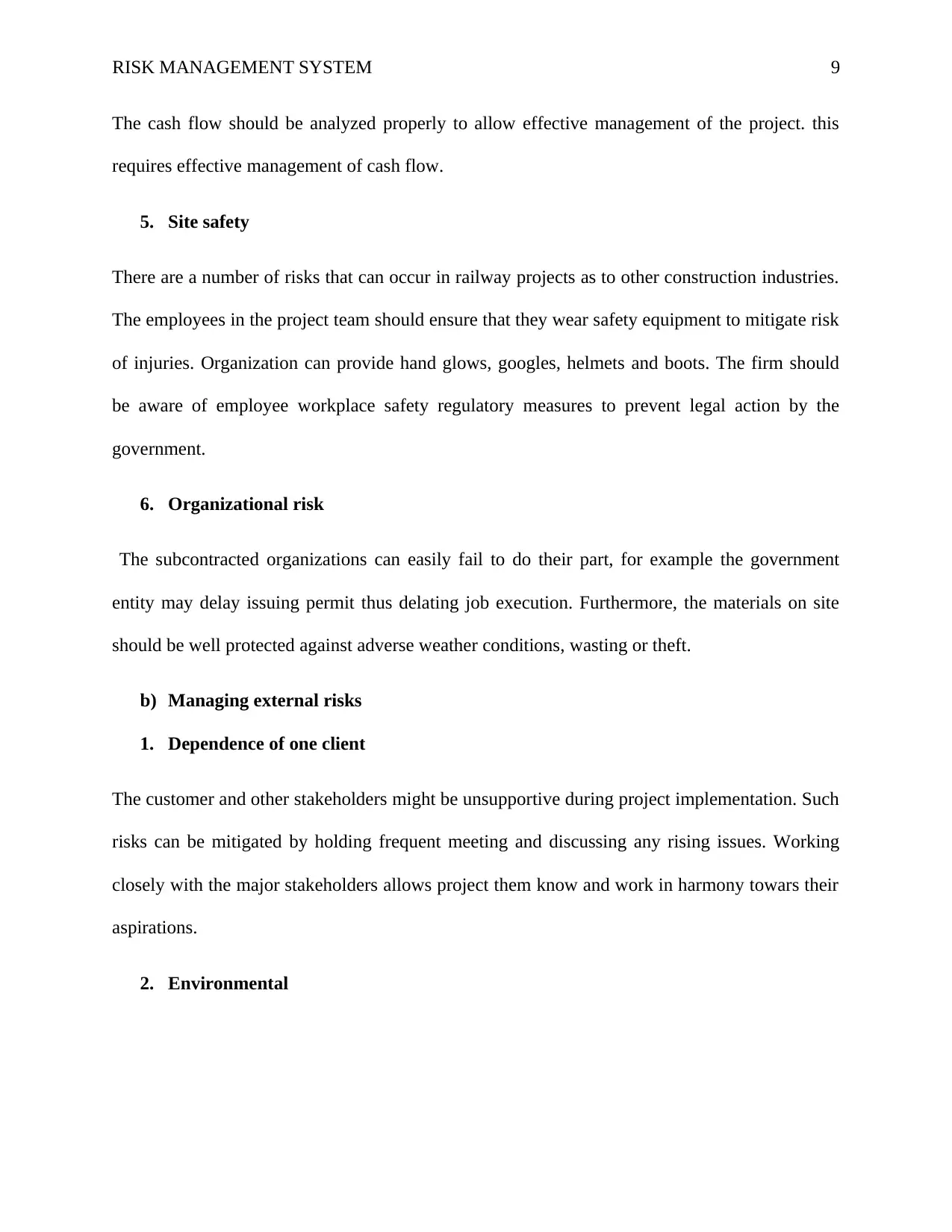
RISK MANAGEMENT SYSTEM 9
The cash flow should be analyzed properly to allow effective management of the project. this
requires effective management of cash flow.
5. Site safety
There are a number of risks that can occur in railway projects as to other construction industries.
The employees in the project team should ensure that they wear safety equipment to mitigate risk
of injuries. Organization can provide hand glows, googles, helmets and boots. The firm should
be aware of employee workplace safety regulatory measures to prevent legal action by the
government.
6. Organizational risk
The subcontracted organizations can easily fail to do their part, for example the government
entity may delay issuing permit thus delating job execution. Furthermore, the materials on site
should be well protected against adverse weather conditions, wasting or theft.
b) Managing external risks
1. Dependence of one client
The customer and other stakeholders might be unsupportive during project implementation. Such
risks can be mitigated by holding frequent meeting and discussing any rising issues. Working
closely with the major stakeholders allows project them know and work in harmony towars their
aspirations.
2. Environmental
The cash flow should be analyzed properly to allow effective management of the project. this
requires effective management of cash flow.
5. Site safety
There are a number of risks that can occur in railway projects as to other construction industries.
The employees in the project team should ensure that they wear safety equipment to mitigate risk
of injuries. Organization can provide hand glows, googles, helmets and boots. The firm should
be aware of employee workplace safety regulatory measures to prevent legal action by the
government.
6. Organizational risk
The subcontracted organizations can easily fail to do their part, for example the government
entity may delay issuing permit thus delating job execution. Furthermore, the materials on site
should be well protected against adverse weather conditions, wasting or theft.
b) Managing external risks
1. Dependence of one client
The customer and other stakeholders might be unsupportive during project implementation. Such
risks can be mitigated by holding frequent meeting and discussing any rising issues. Working
closely with the major stakeholders allows project them know and work in harmony towars their
aspirations.
2. Environmental
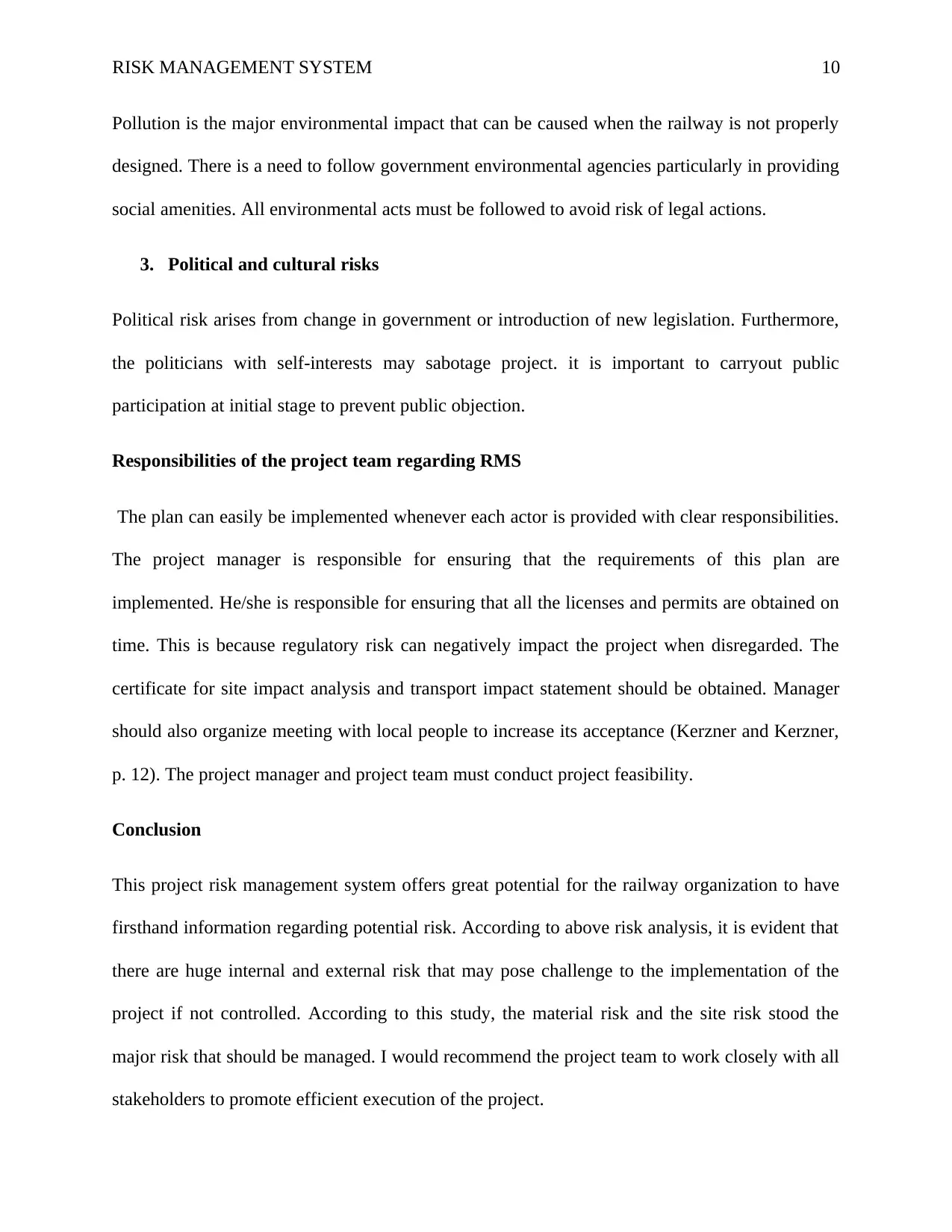
RISK MANAGEMENT SYSTEM 10
Pollution is the major environmental impact that can be caused when the railway is not properly
designed. There is a need to follow government environmental agencies particularly in providing
social amenities. All environmental acts must be followed to avoid risk of legal actions.
3. Political and cultural risks
Political risk arises from change in government or introduction of new legislation. Furthermore,
the politicians with self-interests may sabotage project. it is important to carryout public
participation at initial stage to prevent public objection.
Responsibilities of the project team regarding RMS
The plan can easily be implemented whenever each actor is provided with clear responsibilities.
The project manager is responsible for ensuring that the requirements of this plan are
implemented. He/she is responsible for ensuring that all the licenses and permits are obtained on
time. This is because regulatory risk can negatively impact the project when disregarded. The
certificate for site impact analysis and transport impact statement should be obtained. Manager
should also organize meeting with local people to increase its acceptance (Kerzner and Kerzner,
p. 12). The project manager and project team must conduct project feasibility.
Conclusion
This project risk management system offers great potential for the railway organization to have
firsthand information regarding potential risk. According to above risk analysis, it is evident that
there are huge internal and external risk that may pose challenge to the implementation of the
project if not controlled. According to this study, the material risk and the site risk stood the
major risk that should be managed. I would recommend the project team to work closely with all
stakeholders to promote efficient execution of the project.
Pollution is the major environmental impact that can be caused when the railway is not properly
designed. There is a need to follow government environmental agencies particularly in providing
social amenities. All environmental acts must be followed to avoid risk of legal actions.
3. Political and cultural risks
Political risk arises from change in government or introduction of new legislation. Furthermore,
the politicians with self-interests may sabotage project. it is important to carryout public
participation at initial stage to prevent public objection.
Responsibilities of the project team regarding RMS
The plan can easily be implemented whenever each actor is provided with clear responsibilities.
The project manager is responsible for ensuring that the requirements of this plan are
implemented. He/she is responsible for ensuring that all the licenses and permits are obtained on
time. This is because regulatory risk can negatively impact the project when disregarded. The
certificate for site impact analysis and transport impact statement should be obtained. Manager
should also organize meeting with local people to increase its acceptance (Kerzner and Kerzner,
p. 12). The project manager and project team must conduct project feasibility.
Conclusion
This project risk management system offers great potential for the railway organization to have
firsthand information regarding potential risk. According to above risk analysis, it is evident that
there are huge internal and external risk that may pose challenge to the implementation of the
project if not controlled. According to this study, the material risk and the site risk stood the
major risk that should be managed. I would recommend the project team to work closely with all
stakeholders to promote efficient execution of the project.
Secure Best Marks with AI Grader
Need help grading? Try our AI Grader for instant feedback on your assignments.
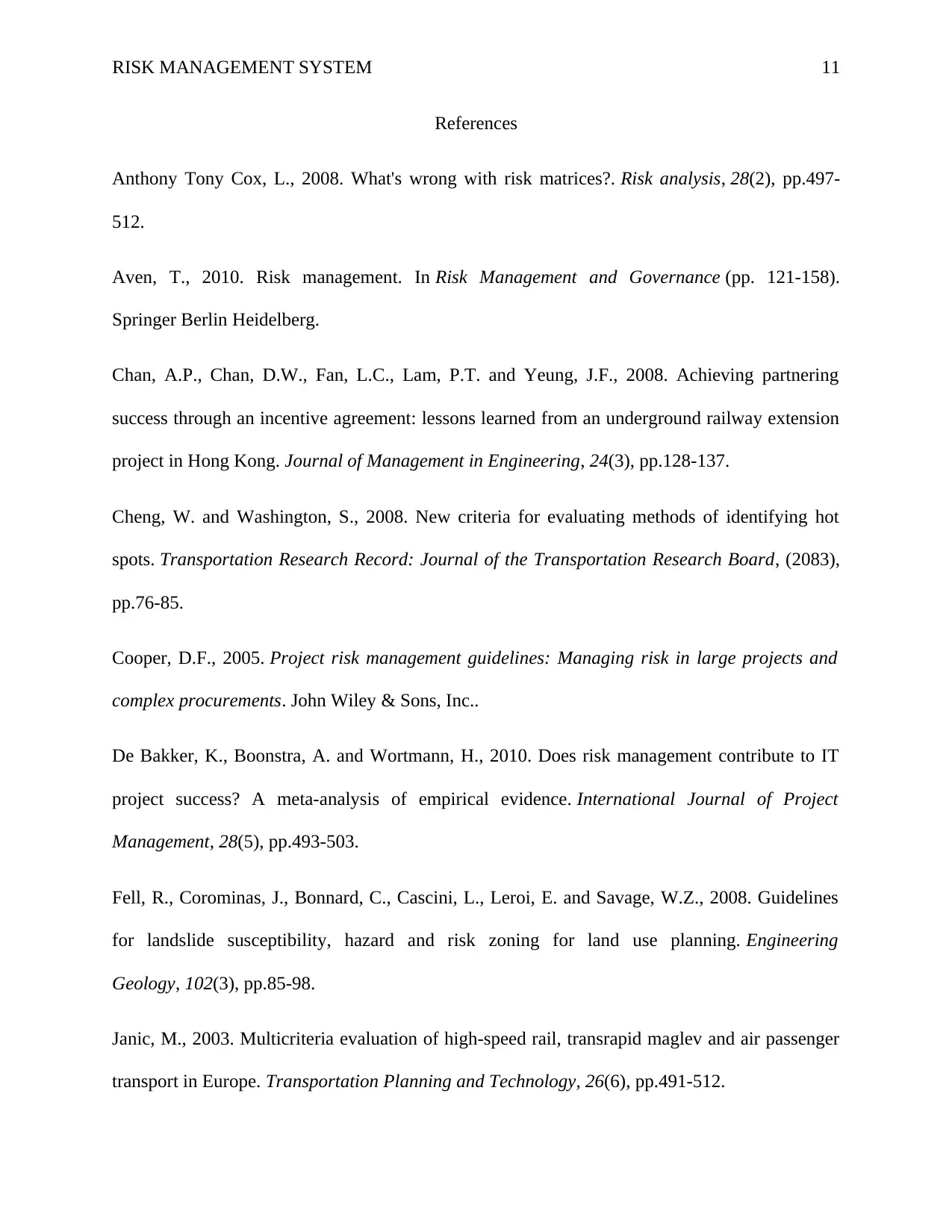
RISK MANAGEMENT SYSTEM 11
References
Anthony Tony Cox, L., 2008. What's wrong with risk matrices?. Risk analysis, 28(2), pp.497-
512.
Aven, T., 2010. Risk management. In Risk Management and Governance (pp. 121-158).
Springer Berlin Heidelberg.
Chan, A.P., Chan, D.W., Fan, L.C., Lam, P.T. and Yeung, J.F., 2008. Achieving partnering
success through an incentive agreement: lessons learned from an underground railway extension
project in Hong Kong. Journal of Management in Engineering, 24(3), pp.128-137.
Cheng, W. and Washington, S., 2008. New criteria for evaluating methods of identifying hot
spots. Transportation Research Record: Journal of the Transportation Research Board, (2083),
pp.76-85.
Cooper, D.F., 2005. Project risk management guidelines: Managing risk in large projects and
complex procurements. John Wiley & Sons, Inc..
De Bakker, K., Boonstra, A. and Wortmann, H., 2010. Does risk management contribute to IT
project success? A meta-analysis of empirical evidence. International Journal of Project
Management, 28(5), pp.493-503.
Fell, R., Corominas, J., Bonnard, C., Cascini, L., Leroi, E. and Savage, W.Z., 2008. Guidelines
for landslide susceptibility, hazard and risk zoning for land use planning. Engineering
Geology, 102(3), pp.85-98.
Janic, M., 2003. Multicriteria evaluation of high-speed rail, transrapid maglev and air passenger
transport in Europe. Transportation Planning and Technology, 26(6), pp.491-512.
References
Anthony Tony Cox, L., 2008. What's wrong with risk matrices?. Risk analysis, 28(2), pp.497-
512.
Aven, T., 2010. Risk management. In Risk Management and Governance (pp. 121-158).
Springer Berlin Heidelberg.
Chan, A.P., Chan, D.W., Fan, L.C., Lam, P.T. and Yeung, J.F., 2008. Achieving partnering
success through an incentive agreement: lessons learned from an underground railway extension
project in Hong Kong. Journal of Management in Engineering, 24(3), pp.128-137.
Cheng, W. and Washington, S., 2008. New criteria for evaluating methods of identifying hot
spots. Transportation Research Record: Journal of the Transportation Research Board, (2083),
pp.76-85.
Cooper, D.F., 2005. Project risk management guidelines: Managing risk in large projects and
complex procurements. John Wiley & Sons, Inc..
De Bakker, K., Boonstra, A. and Wortmann, H., 2010. Does risk management contribute to IT
project success? A meta-analysis of empirical evidence. International Journal of Project
Management, 28(5), pp.493-503.
Fell, R., Corominas, J., Bonnard, C., Cascini, L., Leroi, E. and Savage, W.Z., 2008. Guidelines
for landslide susceptibility, hazard and risk zoning for land use planning. Engineering
Geology, 102(3), pp.85-98.
Janic, M., 2003. Multicriteria evaluation of high-speed rail, transrapid maglev and air passenger
transport in Europe. Transportation Planning and Technology, 26(6), pp.491-512.
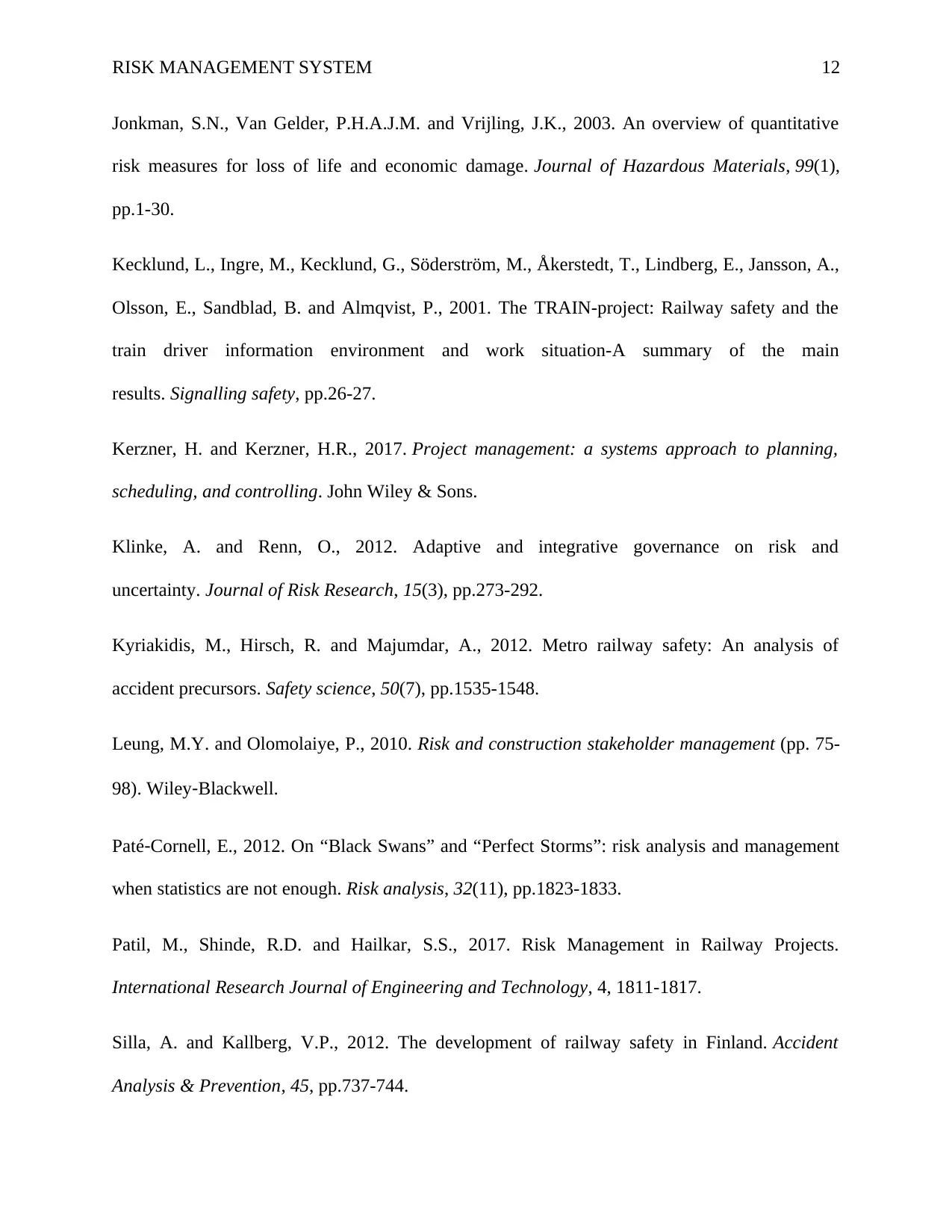
RISK MANAGEMENT SYSTEM 12
Jonkman, S.N., Van Gelder, P.H.A.J.M. and Vrijling, J.K., 2003. An overview of quantitative
risk measures for loss of life and economic damage. Journal of Hazardous Materials, 99(1),
pp.1-30.
Kecklund, L., Ingre, M., Kecklund, G., Söderström, M., Åkerstedt, T., Lindberg, E., Jansson, A.,
Olsson, E., Sandblad, B. and Almqvist, P., 2001. The TRAIN-project: Railway safety and the
train driver information environment and work situation-A summary of the main
results. Signalling safety, pp.26-27.
Kerzner, H. and Kerzner, H.R., 2017. Project management: a systems approach to planning,
scheduling, and controlling. John Wiley & Sons.
Klinke, A. and Renn, O., 2012. Adaptive and integrative governance on risk and
uncertainty. Journal of Risk Research, 15(3), pp.273-292.
Kyriakidis, M., Hirsch, R. and Majumdar, A., 2012. Metro railway safety: An analysis of
accident precursors. Safety science, 50(7), pp.1535-1548.
Leung, M.Y. and Olomolaiye, P., 2010. Risk and construction stakeholder management (pp. 75-
98). Wiley‐Blackwell.
Paté‐Cornell, E., 2012. On “Black Swans” and “Perfect Storms”: risk analysis and management
when statistics are not enough. Risk analysis, 32(11), pp.1823-1833.
Patil, M., Shinde, R.D. and Hailkar, S.S., 2017. Risk Management in Railway Projects.
International Research Journal of Engineering and Technology, 4, 1811-1817.
Silla, A. and Kallberg, V.P., 2012. The development of railway safety in Finland. Accident
Analysis & Prevention, 45, pp.737-744.
Jonkman, S.N., Van Gelder, P.H.A.J.M. and Vrijling, J.K., 2003. An overview of quantitative
risk measures for loss of life and economic damage. Journal of Hazardous Materials, 99(1),
pp.1-30.
Kecklund, L., Ingre, M., Kecklund, G., Söderström, M., Åkerstedt, T., Lindberg, E., Jansson, A.,
Olsson, E., Sandblad, B. and Almqvist, P., 2001. The TRAIN-project: Railway safety and the
train driver information environment and work situation-A summary of the main
results. Signalling safety, pp.26-27.
Kerzner, H. and Kerzner, H.R., 2017. Project management: a systems approach to planning,
scheduling, and controlling. John Wiley & Sons.
Klinke, A. and Renn, O., 2012. Adaptive and integrative governance on risk and
uncertainty. Journal of Risk Research, 15(3), pp.273-292.
Kyriakidis, M., Hirsch, R. and Majumdar, A., 2012. Metro railway safety: An analysis of
accident precursors. Safety science, 50(7), pp.1535-1548.
Leung, M.Y. and Olomolaiye, P., 2010. Risk and construction stakeholder management (pp. 75-
98). Wiley‐Blackwell.
Paté‐Cornell, E., 2012. On “Black Swans” and “Perfect Storms”: risk analysis and management
when statistics are not enough. Risk analysis, 32(11), pp.1823-1833.
Patil, M., Shinde, R.D. and Hailkar, S.S., 2017. Risk Management in Railway Projects.
International Research Journal of Engineering and Technology, 4, 1811-1817.
Silla, A. and Kallberg, V.P., 2012. The development of railway safety in Finland. Accident
Analysis & Prevention, 45, pp.737-744.
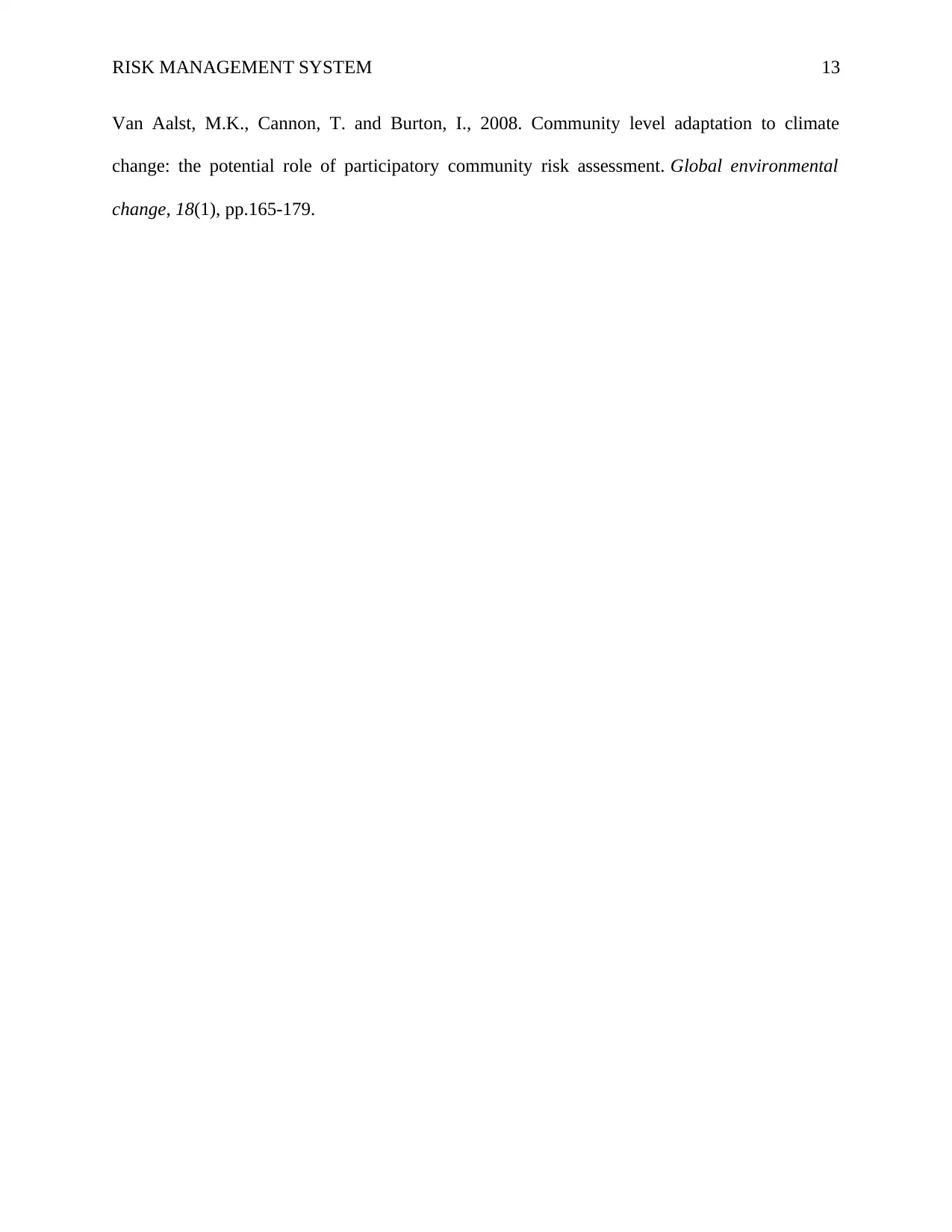
RISK MANAGEMENT SYSTEM 13
Van Aalst, M.K., Cannon, T. and Burton, I., 2008. Community level adaptation to climate
change: the potential role of participatory community risk assessment. Global environmental
change, 18(1), pp.165-179.
Van Aalst, M.K., Cannon, T. and Burton, I., 2008. Community level adaptation to climate
change: the potential role of participatory community risk assessment. Global environmental
change, 18(1), pp.165-179.
1 out of 13
Related Documents
Your All-in-One AI-Powered Toolkit for Academic Success.
+13062052269
info@desklib.com
Available 24*7 on WhatsApp / Email
![[object Object]](/_next/static/media/star-bottom.7253800d.svg)
Unlock your academic potential
© 2024 | Zucol Services PVT LTD | All rights reserved.





